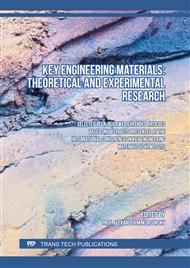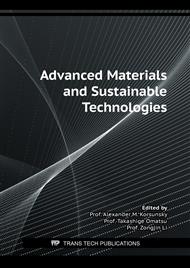[1]
Gacesa,P., Alginates,, Carbohydrate Polymers, vol. 8, no. 3, pp.161-182, (1988).
Google Scholar
[2]
Smidsrod, O. and Skjak-Braek, G. Alginate as immobilization matrix for cells,, Trends Biotechnology, vol. 8, no. 3, pp.71-78, (1990).
DOI: 10.1016/0167-7799(90)90139-o
Google Scholar
[3]
George, M. and Abraham, T. Polyionic hydrocolloids for the intestinal delivery of protein drugs: alginate and chitosan—a review,, Journal of Controled Release, vol. 114, p.114, (2006).
DOI: 10.1016/j.jconrel.2006.04.017
Google Scholar
[4]
Ostberg, T., Vesterhus, L., and Graffner, C., Calcium algiante matrices for oral multiple unit administration: II Effect of process and formulation factors on matrix properties,, International Journal of Pharmacy, vol. 97, no. 1-3, pp.183-193, (1993).
DOI: 10.1016/0378-5173(93)90138-6
Google Scholar
[5]
Zheng, C.H., Gao, J.Q., Zhang, Y.P., and Liang, W.Q., A protein delivery system: biodegradable alginate–chitosan–poly(lactic-co-glycolic acid) composite microspheres,, Biochemical and Biophysical Research Communications, vol. 323, pp.1321-1327, (2004).
DOI: 10.1016/j.bbrc.2004.09.007
Google Scholar
[6]
del Valle, L.J., Diaz , A., and Puiggali, J., Hydrogels for biomedical applications: Cellulose, chitosan, and protein/peptide derivatives,, Gels, vol. 3, no. 3, p.27, (2017).
DOI: 10.3390/gels3030027
Google Scholar
[7]
Selim, I.Z., Basta, A.H., Mansour , O.Y. and Atwa, A.I. Hydroxyethyl cellulose. II. IR spectra and their relation with the dielectric properties of hydroxyethyl celluloses,, Polymer-Plastics Technology and Engineering, vol. 33, no. 2, pp.161-174, (1994).
DOI: 10.1080/03602559408015293
Google Scholar
[8]
Zhang, Z., Zhang, R., Zou, L. and McClements, D.J., Protein encapsulation in alginate hydrogel beads: Effect of pH on microgel stability, protein retention and protein release,, Food Hydrocolloids, vol. 58, pp.308-315, (2016).
DOI: 10.1016/j.foodhyd.2016.03.015
Google Scholar
[9]
Cetin, M., Vural, I., Capan, Y. and Hincal, A.A., Preparation and characterization of BSA loaded alginate microspheres,, Journal of Pharmaceutical Science, vol. 32, pp.103-107, (2007).
Google Scholar
[10]
Coppi, G., Iannuccelli, V., Leo, E., Bernabei, M. and Cameroni, R., Protein immobilization in crosslinked alginate microparticles,, Journal of Microencapsulation, vol. 19, no. 1, pp.37-44, (2002).
DOI: 10.1080/02652040110055621
Google Scholar
[11]
Zhang, J., Li, X., Zhang, D. and Xiu, Z., Encapsulation efficiency and release behaviors of bovine serum albumin loaded in alginate microspheres prepared by spraying,, Wiley InterScience, (2008).
DOI: 10.1002/app.28753
Google Scholar



